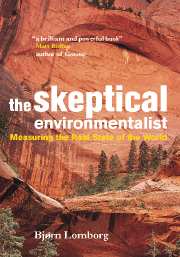Book contents
- Frontmatter
- Contents
- List of figures
- List of tables
- Preface
- Language and measures
- Acknowledgements
- Permissions
- Part I The Litany
- 1 Things are getting better
- 2 Why do we hear so much bad news?
- Part II Human welfare
- Part III Can human prosperity continue?
- Part IV Pollution: does it undercut human prosperity?
- Part V Tomorrow's problems
- Part VI The Real State of the World
- Notes
- Bibliography
- Index
2 - Why do we hear so much bad news?
Published online by Cambridge University Press: 05 March 2013
- Frontmatter
- Contents
- List of figures
- List of tables
- Preface
- Language and measures
- Acknowledgements
- Permissions
- Part I The Litany
- 1 Things are getting better
- 2 Why do we hear so much bad news?
- Part II Human welfare
- Part III Can human prosperity continue?
- Part IV Pollution: does it undercut human prosperity?
- Part V Tomorrow's problems
- Part VI The Real State of the World
- Notes
- Bibliography
- Index
Summary
In 1992 a large-scale opinion poll Health of the Planet was carried out in many countries. The intention was to investigate people's attitudes to the environment and to what extent fears for the environment only manifest themselves in the rich countries. Many of those consulted expressed fears for the environment. In 16 out of the 24 countries involved in the survey, the environment was named as one of the three most important problems. In the vast majority of nations, both developing and industrialized, more than 50 percent of all people were concerned about problems with environment. But then the interviewees were asked for their opinion about the environment locally, nationally and globally. Their answers can be seen in Figure 10.
Notice that in the vast majority of countries surveyed, the impression of its citizens is that the global environment is in the worst shape, the national environment is a little better, and finally, their local environment is in the best shape of the three, although we can see some tangible, concrete problems in for example the transitional economies of Russia and Poland.
- Type
- Chapter
- Information
- The Skeptical EnvironmentalistMeasuring the Real State of the World, pp. 34 - 42Publisher: Cambridge University PressPrint publication year: 2001



